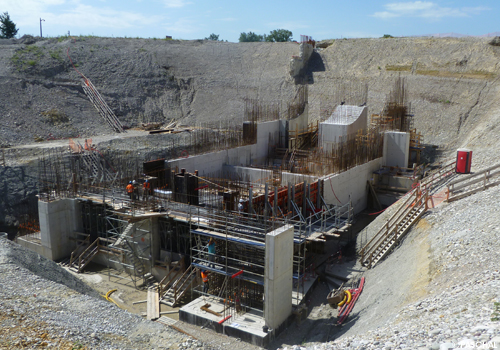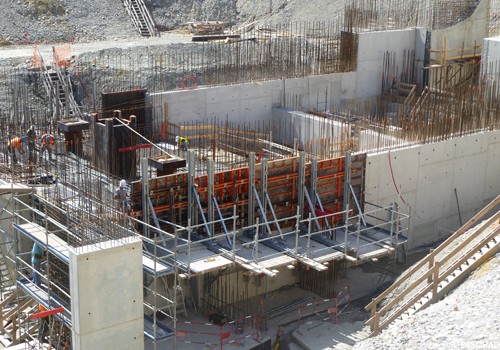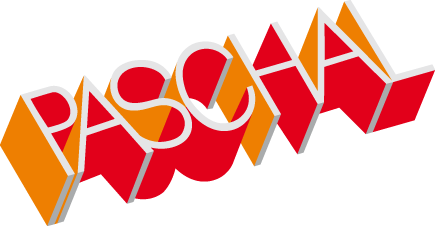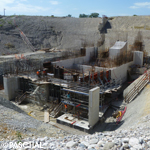Energy generation and environmental conservation in harmony
EDF is currently upgrading the Strasbourg and Kembs dams with hydro-power plants and fish ladders.Both construction projects are being conducted by regular customers of PASCHAL-Werk G. Maier GmbH.
Eiffage TP is working on the dam change in Kembs, and the construction company GTM (PaP Strasbourg) is handling the dam in Strasbourg.
PASCHAL supports its two regular customers in all reinforced concrete construction with imaginative formwork planning and special system-compatible panels, thereby helping to stay within the construction budgets.
Although the two complex hydraulic engineering projects consist almost entirely of reinforced concrete, the contractors are managing to accomplish their objectives with reasonable amounts of formwork systems from PASCHAL. This is thanks to the work preparation of PASCHAL, as well as the perfectly matched planning of the individual construction phases on the part of all those involved in the construction, which are part of established teams.
 The dam crest of the Kembs barrage in the background, as well as the inlet and outlet structure (which is currently under construction), illustrate the civil engineering challenges.
The dam crest of the Kembs barrage in the background, as well as the inlet and outlet structure (which is currently under construction), illustrate the civil engineering challenges.
Similarities between the two projects
The French energy group EDF is having one fish ladder and one hydropower plant built on each of the Strasbourg and Kembs dams.
The two construction projects are connected to the renewal of the operating concession, which is initially fixed until December 2035, as well as the requirement that the unimpeded fish migration to Basel be enabled by 2020.
Fish ladders and turbine houses
Along with the complex requirements placed upon the different concrete structures of the fish ladders, the turbine housings, as well as the inlet and outlet structures, each of which have to meet specific requirements, there are also complex construction situations so close to the Rhine.
Furthermore, each structure has to meet its requirements in itself as well as overall for the long term, whether in the water, under water, or as a water boundary.
The flow rate is reduced in the fish ladders through the use of concrete barriers, allowing the fish migrating upstream to have some time to recover in the still water.
In the inlets for the turbine, the water has to be brought to speed in order to produce as much electrical energy as possible. Therefore, it is clear that every structure has to fulfil its tasks specifically, so that the entire system works as a whole.
Angles and slopes were needed
As a result, the fish ladders are characterised by inclined planes, angled walls and bent barriers.
In order to be able to manufacture these diverse geometrical shapes accurately according to form technology, the application technology of PASCHAL has proven very beneficial in terms of planning performance.
On the basis of the planned courses of the fish ladders, the formwork planning was carried out in phases, with a maximum of standard panels from LOGO.3 intended to be used.
In order to achieve the respective predetermined angular course (vertically and horizontally), the formwork experts of PASCHAL used CAD to construct eight conical filler posts which are compatible with LOGO.3.
With the formwork drawings supplied by PASCHAL, the builders were able to combine and assemble the formwork panels quickly. The existing connecting pieces fit, whether bolts, multi-clamps or wedge clamps.
Concrete versus earth pressure and buoyancy
The concrete structures to accommodate the turbines are characterised by mass and buoyancy safeguards.
In Strasbourg for example, before the respective base plate could be created, double-T-beams were driven into the ground and the "heads" were concreted.
The underground turbine house walls were concreted in Strasbourg 6.50 m high, single-sided, against the previously rammed sheet piles.
63m² formwork panels of the LOGO.3 system were mounted to a formwork and put in place by crane for the single-sided formwork.
The completion of the 6.50-m-high concrete walls was followed by the vertical continuation to a height of approximately 9.0 m. For this purpose, rented LOGO.3 formwork panels were used.
In Strasbourg, from the start of construction in September 2013 to completion in March 2016, approximately 2,000 m³ of underwater concrete and about 7,000 m³ of concrete will be processed with a watercement ratio of 0.45.
In Kembs, TTR circular formwork will also be used, due to further design requirements. The concrete to be formed in Kembs adds up to around 12,500 m³.
At the inlet structure for Kembs, for example, the slab plate is 8.0 m thick. For safe formwork, LOGO.3 was equipped with the "Multip" platform bracket. To absorb the enormous pressure forces, supporting jacks and dam brackets were used at a distance of 1.20 m.
The earthworks in Kembs already began in mid-2011. The structural work is to be completed by the end of 2015, and initial operation is planned for 2017.
 In the foreground is the LOGO.3 in combination with dam brackets on the Kembs dam building site.
In the foreground is the LOGO.3 in combination with dam brackets on the Kembs dam building site.




